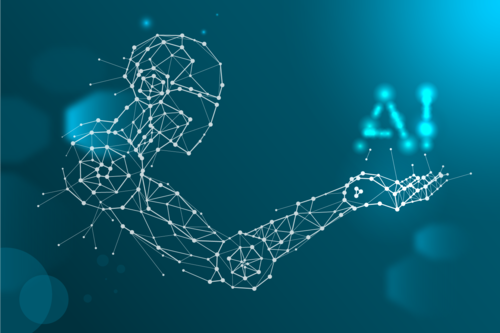How Artificial Intelligence Is Supporting Humanity in the Battle Against Coronavirus

VAISHALI1840265 VIA WIKIMEDIA
As technology evolves, humanity’s approach to curating prophylactics follows suit.
April 1, 2020
Coronavirus is here. It is spreading globally, the numbers are skyrocketing and it is scary.
What face masks, gloves and disinfectants are to the human body, artificial intelligence (AI) could be to our entire system: protection. But how effective is this particular AI layer of protection for the current pandemic and how will it change for potential future ones?
Let’s examine how AI is aiding the battle against coronavirus and the possibility of it not being the knight in shining armor as so many are hoping for. We might need to accept the fact that while AI will not be our lone savior this time, it might provide a thicker layer of protection from future pandemics.
Together with genetic applied science, AI is not only supporting our understanding of how this virus spreads but also helping us manage and contain its devastating effects. By predicting pandemics, tracking infected individuals, optimizing the disease management process and stimulating the drug discovery and development process, AI is able to assist us already. AI is using machine learning in order to generate automated analytical models from data. Via the use of algorithms the AI can parse massive amounts of data, learn from it, identify patterns and generate determinations and predictions.
It was in fact the automated HealthMap service at Boston Children’s Hospital (a former Google technology) which sent out the first public alert about the novel coronavirus on Dec. 30, 2019, at 11:12 p.m., while assessing the risk level at three out of five.
Only a couple of hours later, the AI database company BlueDot sent out a warning to its clients like the Centers for Disease Control and Prevention and the World Health Organization (WHO) to avoid Wuhan, China. It would take another nine days until the WHO sent out a notice on Jan. 9, 2020.
Nevertheless, 30 minutes after the HealthMap warning, a detailed report was sent out by the human-lead team of New York epidemiologist Marjorie Pollak via the volunteer-led Program for Monitoring Emerging Diseases (ProMed). Hence, in regard to detecting this pandemic, AI is not the clear-cut winner in the race.
In the future however, AI-powered systems will probably be able to expand their prediction head start with even larger datasets and more advanced technology.
Yet, AI has some pretty precise predicting skills already. The San Francisco-based AI company Metabiota accurately predicted on Feb. 25, 2020, that the countries most likely to report new cases will be, among others, China, Italy, Iran and the U.S.
Nevertheless, predicting how COVID-19 will progress from now on is extremely difficult. AI systems depend on huge amounts of prior data as a foundation in order to be able to efficiently and accurately interpret new facts. However, there is not enough prior data about enforced country lockdowns for an extensive analysis. Furthermore, news outlets and official reports differ occasionally, and the list of symptoms seems to vary, too. Moreover, the current situation in hospitals is at times unclear and chaotic.
In order to be able to precisely predict the future, you need a clear set of data of the present situation. To AI’s machine learning, noise is what poison is to the body. Yet, AI can assist in examining the scale of the “infodemic” and identify propagation of misinformation.
A potential option to clear up this fog for machine learning algorithms, is via the trade-off our data privacy and AI ethics guidelines. Restrictions and limitations on data privacy and trustworthy AI, are risking to slow down the race to develop algorithms as well as vaccines to battle the virus. Countries like China, South Korea and Singapore with stricter surveillance measures, such as apps to monitor the infected and efficiently gather data for machine learning, have so far been more successful at containing the disease’s outbreak than places with less surveillance like in the EU.
Social media might be one of the future’s most targeted data hotbeds for, predicting outbreaks, detecting illnesses and tracking via analyzing its numerous posts, something which has already started in certain countries, especially in China. This pandemic will most likely spark a fiery debate in many countries about privacy rights in regard to healthcare. Regulators might have to reassess and weigh-up AI ethics and data privacy with the public health. A potential solution for stricter privacy laws like the GDPR in the EU might be the use of synthetic data rather than real data.
In China, you can use an app in order to detect whether you were in close contact with someone infected with COVID-19. For that purpose, users scan a QR code with their respective mobile apps, such as Alipay or WeChat in order to detect whether they are at risk based on their proximity to someone who is either suspected of being infected or has been infected. The system is officially called the Alipay Health Code. After the users sign up, they are being assigned generated automated conclusions about their health status in the form of a color code — green, yellow or red. Green indicates an unrestricted moving around allowance, yellow code may ask someone to stay at home for seven days while the red code orders a two-week quarantine.
Nevertheless, it is not fully transparent how the system classifies people, but it is believed that the users’ data is being shared with the police.
Similarly, South Korea’s Ministry of the Interior and Safety has created an app to watch its quarantined citizens. Via GPS, the app keeps track of its users location to ensure the quarantine rules are being followed. Moreover, the app enables the users to report symptoms and status updates to officials.
Even in Germany, a country with strict privacy data laws, the idea of an app for tracking its citizens with regard to ways of infections is being discussed.
Furthermore, an AI could be used by healthcare analytics companies to extract the relevant information about the novel coronavirus from patient records. It could potentially be able to identify those at most risk, successful treatment patterns and other patterns humans are not even aware of. The bigger and more global the data sets that an AI can analyze, the more valuable information we will receive at an accelerated speed. This goes as well for the diagnostic treatment of COVID-19. Viruses don’t operate in geopolitical boundaries.
AI can also aid in minimizing fatality and in the optimization process of disease management by alleviating the burden on the healthcare professionals. Spain just invested in four robots powered with AI in order to upscale its daily testing for coronavirus to 80,000 a day and at the same time reduce medical practitioners’ exposure to the disease. In China, robots are being used to provide faster diagnostic checks and ambulances are assisted by AI to speed through traffic. Autonomous vehicles in China are carrying out non-contact tasks such as delivering goods in infected areas or providing the medical staff at, for instance, the Beijing Haidian Hospital with daily supplies and food deliveries. Furthermore, AI-powered smart glasses by Rokid are being used in China which can check the temperature of several hundred people in just two minutes from 1 meter away.
Additionally, machine-learning models are sometimes able to catch early signs of a disease that human doctors missed. It comes to no surprise that papers suggesting using this technology for COVID-19 detection from CT scans are on the rise. Last week, the company DarwinAI released an open-access convolutional neural network, a type of AI, called COVID-Net for diagnosis via image recognition from chest X-rays. Nonetheless, physical signs may not show up on the scans early on, which limits its suitability as an early diagnostic tool. Moreover, at this stage, most papers are not peer-reviewed and very few reviewed systems have operational maturity, the United Nations’ Artificial Intelligence Initiative Global Pulse, the WHO and the Mila Quebec Artificial Intelligence Institute warn in a newly released report.
Another aspect where AI can come in handy is drug discovery and scaling its development. The AI system of Insilico Medicine managed to identify thousands of molecules for a potential coronavirus medication in only four days. Chinese scientists were able to recreate the genome sequence in just one month with the help of AI, accelerating the search for a vaccine tremendously.
In comparison, it took several months to recreate the genome sequence for the SARS virus in 2003 because scientists used traditional methods. South Korean biotech company Seegene, used AI to accelerate the development of testing kits to only 3 weeks instead of 2 to 3 months. Similarly, the Isreaeli Defense Ministry just launched a voice-test study powered by AI for the novel coronavirus. The gathered voice samples will be analyzed via an AI algorithm in the hope to identify a voice ‘fingerprint’, as the virus affects the respiratory system and could be identified in a person’s breathing and voice.
While AI is also used to speed up the process in the quest of the vaccine, it still takes a lot of testing until it will be allowed to be released on the market. There are several other companies such as Daergen, SRI Biosciences and Iktos and Benevolent AI that are working on finding a cure with the use of AI.
The role of tech companies will grow even more in future health care debates. China’s biggest tech companies, Alibaba, Tencent, Baidu and many more have stocked up their AI means to aid the fight against coronavirus, often at the cost of the data privacy of their users.
It is impossible to predict in what kind of world we will find ourselves in after we return to our new normal. But one thing is for sure, governments and companies around the globe will expand every possible capacity to prevent another pandemic. At the center of their efforts will be artificial intelligence.
Ultimately, AI will not be our savior against coronavirus, but it might protect us from a pandemic ever happening again.










